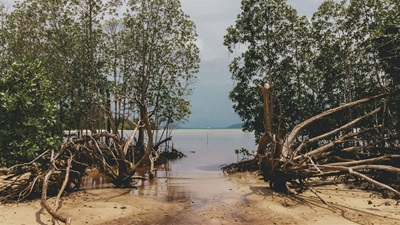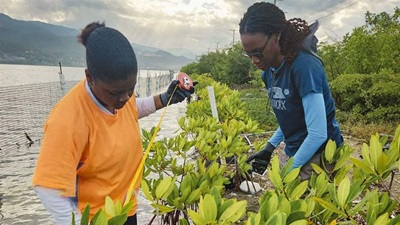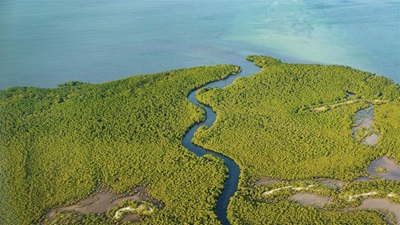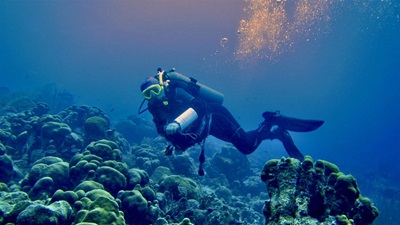In the Western Indian Ocean, Seagrass Is Becoming ‘Underwater Ally’ in a Changing Climate
A 4-nation initiative is working to protect ecosystems that support millions of livelihoods

The Western Indian Ocean harbors an extraordinary diversity of marine life. This rich environment, home to dugongs, sea turtles, and lush seagrass meadows, has fostered a growing community of researchers, conservationists, and policymakers who are committed to understanding and protecting the region’s marine ecosystems. During the recent Western Indian Ocean Marine Science Association (WIOMSA) Scientific Symposium in Mombasa, Kenya, which concluded on Oct. 3, staff from The Pew Charitable Trusts had the opportunity to learn from this community and to share experiences in mapping seagrass—a critical and under-protected ecosystem in the region.
Why seagrass matters
Seagrass meadows—which are found on the fringes of every continent except Antarctica—are an essential habitat for fish, clams, and other key seafood species. Of the fish people eat, around one in five has relied on a seagrass meadow at some point in its life. In the Western Indian Ocean, seagrass meadows provide habitat, nursery, and feeding grounds for commercially important fish species, such as mullet and rabbitfish, and play a significant role in food security and the livelihoods of coastal communities.
Beyond supporting fisheries, seagrass meadows also defend shorelines from erosion and store carbon in the seabed, which helps protect communities and build climate resilience. Even with these benefits, seagrass remains largely invisible to many policymakers and the public, in part because many governments haven’t mapped the location and extent of their seagrass meadows—a significant barrier to effective conservation and management.
A collaborative partnership for conservation
The good news is that this is changing. The Pew-supported Large-Scale Seagrass Mapping and Management Initiative (LaSMMI), which took part in the symposium, is developing the first standardized, field-verified seagrass map and carbon assessment for Kenya, Madagascar, Mozambique, and Tanzania (including Zanzibar).
LaSMMI is a regional collaboration, bringing together Pew, WIOMSA, the University of Southampton, and research institutions across the four countries—including the Kenya Marine and Fisheries Research Institute, the University of Dar es Salaam, State University of Zanzibar, Eduardo Mondlane University, and the University of Toliara’s Institute of Fisheries and Marine Sciences.
LaSMMI also aligns with Pew’s ongoing commitment to support countries in protecting and sustainably managing these critical seagrass habitats for the benefit of people and nature.
The initiative builds on recent success in the Seychelles: The 115-island archipelago off the east coast of Africa is among the first nations in the world to create a field-verified seagrass map and estimate how much carbon its seagrasses store. This data informed the government’s commitment to protect seagrass meadows to help it meet its commitments under the Paris Agreement. LaSMMI aims to provide similar scientific foundations for seagrass protection across the Western Indian Ocean.
Building regional momentum
With a technical approach that combines cutting-edge satellite technology with on-the-ground expertise, LaSMMI partners will continue conducting intensive field surveys to accurately map seagrass ecosystems and collect sediment samples.
These field campaigns will also provide invaluable opportunities for students to participate in hands-on research, fostering knowledge exchange and building regional expertise that should pay dividends for decades to come.
The project aims to complete standardized seagrass maps by the end of 2026. Importantly, LaSMMI is working to raise national and regional awareness for seagrass conservation and advance the scientific baseline needed to enable inclusion of seagrass protection within management frameworks.
Together, through collaborative partnerships that bridge science and policy, LaSMMI aims to lay the foundation for stronger conservation by advancing the science for a critically important but often overlooked ecosystem. The seagrass meadows of the Western Indian Ocean support the livelihoods of millions—and with better data, stronger partnerships, and increased awareness, we can ensure they continue to thrive for generations to come.
Stacy Baez works on The Pew Charitable Trusts’ advancing coastal wetlands conservation program.








